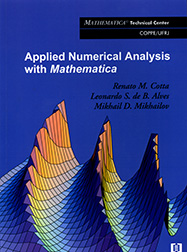|
|

Description
The goal of this course is to teach the fundamentals of Mathematica as a numerical calculus platform, introduce an applied numerical analysis concept to engineering and physical sciences students, and illustrate how this software system can effectively be employed as a numerical analysis assistant, by making use of its huge collection of built-in algorithms for numerical computations and their error control and method variation alternatives. The topics for the notebooks here developed were selected from the list of subjects pointed out in some of the most important treatises on numerical analysis available in the literature [Scheid, 1968], [Ralston & Rabinowitz, 1978], [Conte & De Boor, 1980], [Burden, Faires, A. C. Reynolds, 1981], [Maron, 1982], [Rice, 1983] listed below. To demonstrate the power of Mathematica as a numerical analysis tool, in the present book we also solve several problems published in established numerical analysis textbooks and some encountered in our own professional activities. The first notebook (ANA0) introduces the student to the Mathematica system, illustrating the most important concepts and commands that will be required in the basic understanding of the notebooks to follow. The second notebook (ANA1) discusses the questions of precision and accuracy in scientific computation, and how the system deals with fixed and variable precision arithmetic. The next eight notebooks (ANA2 through ANA9) deal with the most common computational tasks in numerical analysis, starting with polynomial interpolation and up to the solution of boundary value problems. This material is not aimed at reviewing the basic algorithms of numerical calculus, which should have been covered in more elementary courses, but rather to identify and exercise the most appropriate built-in functions for each computational task and, most important, to introduce and stimulate the use of the software system itself as a numerical analysis assistant, in building confidence on the numerical results thus obtained. The next two notebooks (ANA10 and ANA11) are more advanced material, which might have to be avoided depending on the level of the course being offered and on the maturity of the students on this software system. They include research work by the authors on the use of the Integral Transform Method in the solution of differential eigenvalue problems and nonlinear partial differential equations, respectively. These two notebooks are also intended to demonstrate the advanced programming capabilities of the Mathematica system, towards the handling of more involved tasks not readily available as built-in functions within this platform, while introducing and inviting the interested reader towards a more recent electronic book by M. D. Mikhailov and R. M. Cotta, The Integral Transform Method with Mathematica, especially devoted to such topics. Finally, a selection of problems is available from the authors, extracted from the various textbooks here considered, that includes the material covered along the above notebooks, which offers an excellent training and examination environment in electronic version. Related Topics Applied Mathematics |
|
|